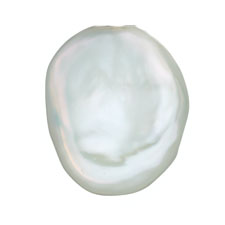
The Keshi Pearl
Quite often, the nucleus is rejected by the oyster. And that despite everything layers of mother-of-pearl cover a grain of sand. We then obtain a keshi. A keshi is small, it has no nucleus, and is often quirky in shape. It is a pearl "failed" in short. But with the reflections and colors that the pearl would have had, this "streak" has a lot of charm and is sought after in jewelry.
The CIBJO recognizes four categories of pearls: natural pearls (very rare), cultured pearls, composite pearls, imitation pearls. In addition, there are two categories of freshwater or seawater.
The value of pearls is determined by their shape (symmetry), their shine, their size, their color and their weight.
Pearls are divided into eight basic shapes: round, semi-round, button, drop, oval, pear, baroque, banded.
The brilliance (or luster of the pearl) is the most important criterion for judging the quality of a pearl, especially for jewelers; but the larger the pearl, the more expensive it is. Large, perfectly round pearls are very rare, and highly sought after for necklaces with several rows.
The thickness of the mother-of-pearl is a criterion determining the quality of a pearl. Mother-of-pearl can be considered as the essence of the pearl, because it will give it its luster, hue and durability. A thick mother-of-pearl allows the pearl to maintain its hue and appearance durably, unlike the fine mother-of-pearl which, even if it can be very beautiful, will have more trouble lasting over time.
A little history...
Pearls have been used to make jewelry since Antiquity; they were called Aphrodite's tears. The Roman families who could afford it, bought their daughters one or two pearls each year, so that they had a full necklace when they reached their majority.
Provenance
The Keshi Pearls, very appreciated by the jewelers, are produced fortuitously alongside the pearls caused voluntarily by the pearl growers. Those of Tahiti are very famous.
The Keshi Pearl in Astrology
The pearl symbolizes children born in June.
The cultured pearl is linked to the sign of Cancer.
It is traditionally offered for the 30th wedding anniversary.
The keshi Pearl in lithotherapy
The pearl, called “Margarita” in Greek, was the queen of gems in Antiquity. It is the symbol of love, happiness and luck. Bright and sensual, it perfectly embodies softness and femininity. The pearl is soft, tender and feminine. Like mother-of-pearl, it would provide soothing and well-being; it would have positive effects on the problems of decalcification.
Take care for your Keshi Pearl
The pearls should be cleaned with a damp cloth.
Our selection of Keshi Pearl jewelry
- Keshi Pearl rings
- Keshi Pearl necklaces
- Keshi Pearl bracelets
- Keshi Pearl earrings